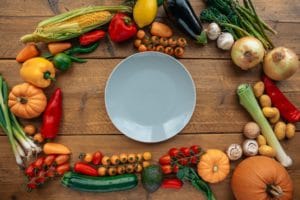
What will it take to eat more fruits and vegetables? Let’s reflect.
Just the Facts
According to Produce for Better Health’s (PBH) “State of the Plate: American’s Fruit & Vegetable Consumption Trends,” our consumption patterns don’t look good. Here are some reality checks:1
- Nine out of 10 Americans are not eating enough fruits and vegetables each day. In fact, most of us only eat ONE serving of fruits and vegetables daily! (Goal: 4-5 cups/servings daily)
- Our fruit and veggie intake has decreased about 10% since 2004, when the PBH “State of the Plate” research began, despite efforts of the public health community and produce industry.
- Consuming vegetables less frequently and reducing fruit juice intake are the most significant factors contributing to this decline.
- Even though consumers over the age of 50 are eating more produce, the increase doesn’t offset the declining intake among Millennials and Gen Z.
- Millennials (those most likely to be parents of young children) are less likely than other generations to include fruit and veggies in their diets. However, this may be changing as fruit intake is starting to increase with this group, while Gen Z and younger are starting to eat more veggies.
The health benefits of daily consumption of fruits and vegetables is well grounded. Strong science suggests that eating fruits and vegetables may reduce our risk for multiple health conditions, including heart disease and certain forms of cancer and obesity, as well as improve our mental and cognitive status.2 Despite the benefits outweighing the risks, we still struggle to close the gap.
Why the Disconnect?
Numerous studies and consumer research have been conducted over the years to explore this question and there is no one solution. Cost and lack of cooking equipment are real barriers to healthy eating in food insecure households.3 For others, preparation skills, time to cook and taste influence buying decisions. Often, what we eat or don’t eat depends on how the food was introduced to us as a child or the messages we see along the way. So, let’s do a little self-analysis:
1. Are fruits and vegetables a “default” choice for meals and snacks? Take an inventory of the fruits and vegetables currently in your refrigerator and pantry. Look at what foods are visible on your kitchen counter, desk or table. Four cups of fruits and vegetables daily may seem daunting but a “cup” may be smaller than you think! For snacks, focus on easy, ready to eat choices like a banana or apple, 22 grapes, eight strawberries or one cup of baby carrots.4 For easy meal preparation, think about items like a medium baked potato or sweet potato, one cup of cooked frozen veggies (microwaveable), canned or frozen fruit, or two cups of salad greens — all of which equal “one serving.” Have lots of options on hand. When options are available, it’s always easier to eat! 5
2. Do you subscribe to the “fresh is best” mantra? I agree that nothing beats the taste of an “in season” homegrown tomato or peaches at their peak from a nearby orchard. (And, I do buy my share of fresh produce from grocery stores and farmer’s markets.) But, when “fresh is best” is viewed from a nutritional standpoint, canned and frozen options are equally nutritious. Just like canning your own tomatoes or freezing corn or broccoli from your garden, you pick produce at the peak of freshness and then process it. Commercial operations are no different! Having participated in a tomato “tour” previously, I can verify that tomatoes were picked, trucked to the canning operation, and canned within four hours! That’s much faster than fresh produce coming from across the country or beyond our borders. And faster is better for nutrient content, especially for water-soluble vitamins like Vitamin C or B, which diminish during long periods of travel and storage.
3. Are “labels” more important than the bottom line? Terms like “local, organic, natural, sustainable, fresh” are parameters we use for decision making when it comes to food in general and often more frequently with produce. More labels usually mean higher prices without a significant nutritional or safety benefit. If you choose to buy organic produce, just know you’re making a choice between food grown using natural fertilizers and pesticides or synthetic options. (Spoiler alert: perfect produce doesn’t come without a little help.) All production practices provide safe produce … and the benefits of eating more outweigh any potential risks. Labels are not status symbols!
4. Do you buy with a plan in mind? Buying more fresh produce than what you and your family can eat before it spoils contributes to wasted dollars and food waste. Even with good intentions, this can happen. So don’t let “specials” and the bounty of farmer’s markets cloud your decisions. Buy “in season” produce, adding frozen or canned varieties to save money, time and reduce food waste. If you need ideas on how make vegetables and fruits come alive at meals, check out the recipes at https://fruitsandveggies.org/recipes and look for #haveaplant social media postings for creative ideas from my colleagues on how to add “one more” to your plate.
Finding the Solution
Now that we know the problem, it’s time to find the solution. Adding one more fruit and vegetable to our daily meals or snacks is doable if we are mindful of what’s in our kitchen and on our plates. This is the International Year of Fruits and Vegetables so now is the time to break our perceived barriers to good health. It’s never too late to start.
References:
1. “2020 State of The Plate Toolkit,” Produce for Better Health. Accessed September 15. 2021.
2. National Fruit & Vegetable Month Toolkit, Produce for Better Health Foundation.
3. “BARRIERS THAT CONSTRAIN THE ADEQUACY OF SUPPLEMENTAL NUTRITION ASSISTANCE PROGRAM (SNAP) ALLOTMENTS (SUMMARY),” USDA Department of Food and Nutrition Services. June 2021.
4. MyPlate Vegetables, U.S. Department of Agriculture.
5. MyPlate Fruits, U.S. Department of Agriculture.

